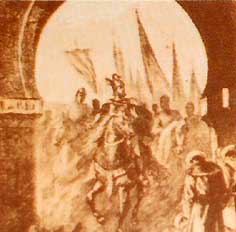La Reconquista
13th century
 As
the forces of Castilla and Aragon moved closer and closer towards Balansyia,
the ruler Zayan made a desperate attempt to meet them in battle. He attacked
a fairly small contingent of Christians but their heavy cavalry turned
the battle into slaughter. Zayan had no choice but to entrench within
the city walls. As
the forces of Castilla and Aragon moved closer and closer towards Balansyia,
the ruler Zayan made a desperate attempt to meet them in battle. He attacked
a fairly small contingent of Christians but their heavy cavalry turned
the battle into slaughter. Zayan had no choice but to entrench within
the city walls.
In April 1238 Balansiya was besieged. The Christians were growing impatient,
threatening to sack the city completely. Finally, on 28 September 1238
Zayan capitluated and on 9 October King Jaime I of Aragon entered the
city in a triumphal procession. This day is still celebrated in Valencia
with a parade of Moors
and Christians, and King Jaime is still the loved founding father
for all Valencians.
King Jaime did not annex the kingdom, however, but decided to give it
autonomy, in order to keep the fragile balance of power amongst the Iberian
monarchies. He granted Valencia its own code of laws - the Furs, which
became the founding stone of Valencian independence.
The conquest was immediately followed by a complete repartition of properties
and territories amongst the King's men. Scores of colonists flocked to
Valencia from Aragon and Catalunia. Very quickly Valencia was reshaped
as a Christian city - both physically and socially. The main mosque was
replaced with the Cathedral,
the streets were aligned and opened wider, and the new population of Valencia
quickly coerced behind the religion and the guilds.
The religion was, in fact, the crucial tool for such a rapid development.
United by Christianity and tightly controlled by eclesiastical hierarchy,
everything in Valencia, from taxes to public holidays and political life,
was organised behind the 12 parishes.
Sights from the period:
Cathedral,
Carmen Convent,
Church of
Santos Juanes
Map: Location of Muslim
Valencia
|